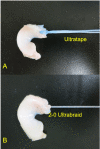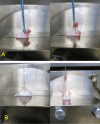Biomechanical Comparison of Two Different Sutures for the Tensile Strength of the Pullout Repair of Posterior Meniscal Root Tear
- PMID: 37492035
- PMCID: PMC10364846
- DOI: 10.7759/cureus.42378
Biomechanical Comparison of Two Different Sutures for the Tensile Strength of the Pullout Repair of Posterior Meniscal Root Tear
Abstract
Background Medial meniscal posterior root tear has garnered attention because it causes increased joint contact pressure and loss of load distribution function. Currently, the common treatment for posterior meniscal root tears is transtibial pullout repair, and loop suture remains the gold standard procedure. Purpose The aim of this study is to validate whether the meniscus-suture complex exhibits better structural properties after loop stitch using a suture tape versus the conventional thread. Study design and methods This is a controlled laboratory study. In total, 20 menisci harvested from castrated male pigs were prepared and randomly assigned to two suturing techniques: loop stitch using ULTRATAPE (n = 10, tape group) or loop stitch using 2-0 UltraBraid (n = 10, control group). The single-loop stitch meniscus-suture technique was used. A single suture using ULTRATAPE or 2-0 UltraBraid was placed through the meniscus 5 mm medial from the resected edge of the posterior meniscus horn. The meniscus-suture complex specimens were mounted on a tensile tester to apply tensile load on the meniscus-suture complex parallel to the long axis of the stitched suture materials. Each specimen was stretched to failure at a crosshead speed of 50 mm/minute. The structural properties of the meniscus-suture complex (maximum load, linear stiffness, and elongation at failure) were determined. Results In the tape group, all the repaired complexes were torn at the ligature; conversely, in the control group, the threads were torn in three of 10 specimens, and the repaired complexes in the remaining seven specimens were torn at the ligature. No significant between-group differences were observed in linear stiffness (9.0 ± 4.1 vs 7.1 ± 2.9 N/mm) and elongation at failure (15.8 ± 6.1 vs 19.6 ± 20.1 mm); however, the tape group exhibited a significantly higher average maximum load than the control group (104.6 ± 41.2 vs 62.6 ± 32.1 N; P = 0.020). Conclusion Suture tape can be a potential alternative to the conventional thread for Medial meniscal posterior root tear repair. Clinical relevance Medial meniscal posterior root tear repair using tape rather than the conventional thread may be beneficial in obtaining better structural properties.
Keywords: medial meniscus posterior root tear; porcine model; surgery; tape; transtibial pull-out repair.
Copyright © 2023, Takahashi et al.
Conflict of interest statement
The authors have declared that no competing interests exist.
Figures
References
-
- Function of the medial meniscus in force transmission and stability. Walker PS, Arno S, Bell C, Salvadore G, Borukhov I, Oh C. J Biomech. 2015;48:1383–1388. - PubMed
-
- Meniscal injuries in the young, athletically active patient. Poulsen MR, Johnson DL. Phys Sportsmed. 2011;39:123–130. - PubMed
-
- Characteristic location and rapid progression of medial femoral condylar chondral lesions accompanying medial meniscus posterior root tear. Park JY, Kim BH, Ro DH, Lee MC, Han HS. Knee. 2019;26:673–678. - PubMed
-
- Biomechanical consequences of a nonanatomic posterior medial meniscal root repair. LaPrade CM, Foad A, Smith SD, et al. Am J Sports Med. 2015;43:912–920. - PubMed
-
- Biomechanical evaluation of a transtibial pull-out meniscal root repair: challenging the bungee effect. Cerminara AJ, LaPrade CM, Smith SD, Ellman MB, Wijdicks CA, LaPrade RF. Am J Sports Med. 2014;42:2988–2995. - PubMed
LinkOut - more resources
Full Text Sources


